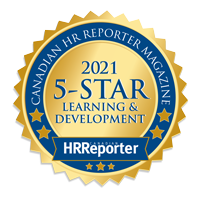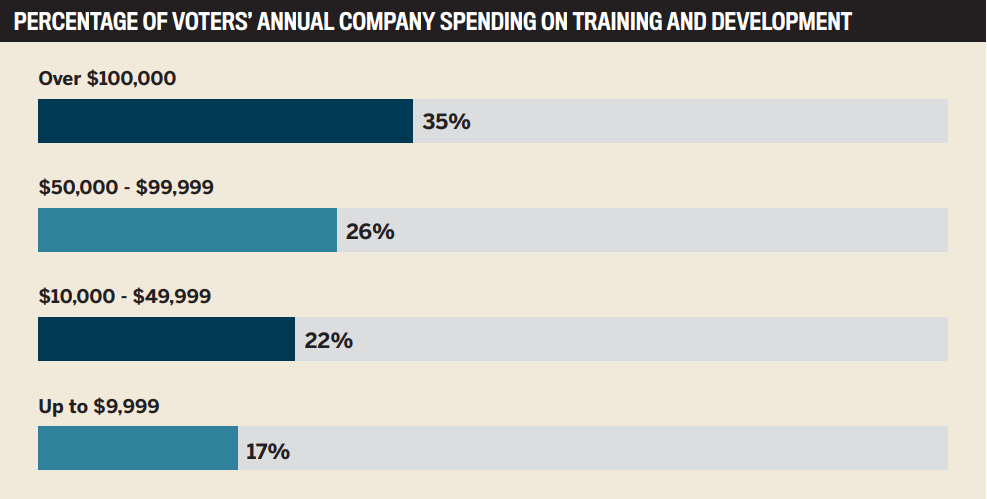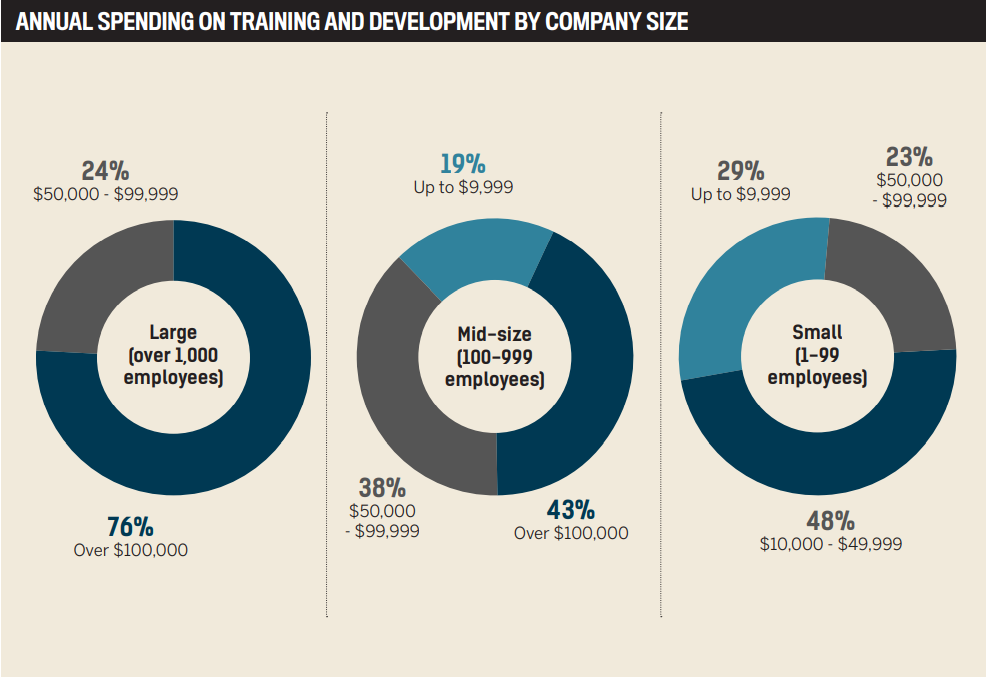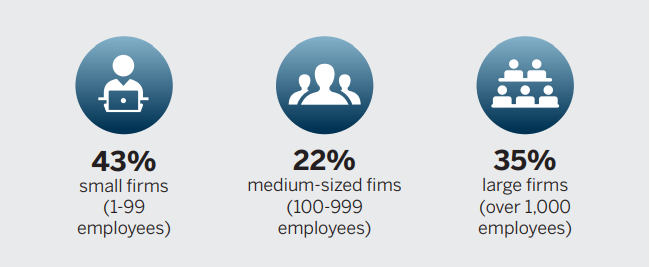

Jump to winners | Jump to methodology | View PDF
Nearly two years of the COVID-19 pandemic have taken a toll on organizations and individual employees, but in the HR space, some bright spots have emerged.
That’s according to three winners of Canadian HR Reporter’s 5-Star Learning & Development awards, who say the tumultuous times have also led to major improvements in L&D as employers and providers revamped their offerings while evolving their focus and strategy.
“It’s one of those silver lining kind of things, where it accelerated [change],” says Janet Clarey, director of HR research and advisory services at McLean & Company in Toronto.
“The classic example would be onboarding. As we realized, ‘Okay, this is going to last a little longer than maybe just a few months or what we thought,’ there was really a step back to say, ‘Let’s reevaluate how we do everything and that whole approach to continuous learning and meeting people where they are, in the flow of their work.’”

Evolving in tough times
Before the pandemic, a lot of training was conducted traditionally, in person. However, the sudden shift to online working brought about other changes, says John Baker, president and CEO of education software company D2L in Kitchener, ON.
“The pandemic has accelerated the need to put in place better learning infrastructures, to support future work, to [improve] onboarding, career development, leadership development, people development across the organization, and help support [employees’] learning growth.”
Although many employers had an emergency response in the spring of 2020, using tools such as WebEx, Teams or Zoom, now they are putting in place more sophisticated offerings “to support a better learning experience … so it’s really been an accelerant for change,” he says.
The other major challenge has been the sheer disruption created in the workforce as people learned how to adapt to either a remote or a hybrid setup, or a combination of these, says Baker.
“[It’s about] being able to put in place better learning technologies and support all those wide varieties of learning experiences,” he says.
“The digitization of the learning environment for the workplace has happened at an unprecedented pace. And while we got a ‘new now,’ the next step is to go beyond just simply digitizing to teach well, to provide a more optimized learning experience for those employees, give them a better opportunity to be successful.”
The pandemic accelerated everything that the L&D function had to do in responding to development needs, says Clarey.
“We see it more as an evolution, so it was a fast-forward moment. It was, ‘OK, now we’re really going to do this. We’ve been talking about things for a number of years, and we’re actually going to move that forward.’”
Long before the pandemic, L&D needed to get closer to the actual work that people were doing and shift away from thinking about courses and classes as a way to solve problems or get people into a learning management system (LMS) to take a course, she says.
“We see this in our 2022 trends research that enabling continuous learning through a really strategic approach is associated with better organization performance, higher HR effectiveness, and the ability to quickly change at scale.”
And now, there’s a focused approach from employers on assessing what they need to be doing in person, says Clarey, because they don’t need to go back and do what they were doing before, even if the pandemic is over.
Those in the security business are busier today than they were prior to the pandemic because so many people have been working from home, shopping online and creating online accounts, making them vulnerable to hackers, says Jim Kootnekoff, president, CEO and founder of SecuSolutions in Calgary, AB.
“They’re using weak passwords, they’re not patching their systems, they’re not utilizing the security protocol or features and products that are available to them, because they don’t know of them.”

Skills in demand
Previously, security software and policies were largely an afterthought for some companies. But now, the issues that appear daily in the news have led to an understanding that security is a serious matter, says Kootnekoff.
“The corporations that we deal with are now realizing that a corporate [or] company handbook or employee handbook that tells you when your lunch breaks are and when your holidays are, and that type of thing, they should also be empowered by some type of formal training,” he says.
“So, the trend is towards HR providing training as an onboarding product. Effectively, right out of the gate: ‘Here’s your cubicle, here’s your company and employee handbook, and here’s your username and password to log on to the security training that you’re going to take before you touch a computer of ours.’”
Companies are realizing that there is no silver bullet approach, and that security is ever evolving, says Kootnekoff.
“There are new issues, new challenges, new phishing [and] hacking techniques. All of this stuff changes like the weather, so [companies are] looking more towards the long term, ‘slow and steady wins the race,’ rather than ‘one and done’ … They are looking at long-term strategy, continuous training.”
There’s also the continued demand for strong technical skills, with cloud technologies and different certifications, along with growing interest in leadership development and personal development in areas such as allyship, and diversity and inclusion, says Baker.
“You’re seeing strong demand for learning how to go through digital transformations … for artificial intelligence and beta skill sets,” he says.
“But you’re also seeing demand for creativity and empathy, so that fits well with design programs that are being offered. Those types of durable skills that cross from one industry to another are certainly in high demand as well.”
The first step is simply digitizing, which is followed by optimizing for better outcomes, where the organization starts to embrace the necessary technologies, he says.
“The final stage is really transforming the experience. So, once you’ve optimized, how do we actually make the experience even better, yet again, by making it more personal, more human, and that’s where you get into new models of learning, like the competency-based models, which we’re finding to be highly effective in the enterprise. It started off in education. But some of our biggest clients globally are now embracing it on the corporate side and having a great impact.”
Having the ability to learn is critical, as the research shows, says Clarey.
“Just under 25% of the high-performing organizations actually said that ‘ability to learn’ is more important than skills and experience. So, we’re seeing a lot more highlights around learning agility, and really investing in L&D initiatives to address skill gaps.
“We do hear a lot of talk about empathy and things that are not functional skills, but [also] more about critical thinking skills, problem-solving skills.”
Also important is the issue of remote and hybrid work, and the need for strong leaders, she says.
“We see in our online courses a big uptick, since the pandemic began, in online development in general, but more demand for strategic HR skills. And then organizations seem to be willing to spend quite a bit on people management skills – and hybrid work highlighted that. So, we’re seeing much more ownership of learning and in terms of developing managers, especially those that are new to the role.”
To select the best learning and development service providers for 2021, Canadian HR Reporter enlisted some of the industry’s leading professionals.
During a 15-week process, the CHHR research team conducted one-on-one interviews and surveyed thousands more within its network to gain a keen understanding of what HR professionals think of current market offerings.
Participants were first asked about which features of L&D platforms and training providers they thought were most important, and how the L&D service providers they dealt with rated based on those attributes.
Across the criteria for the LMS provider category, the winners scored highly on factors such as ease of use, ease of integration, technical support, platform features, management reporting, and value for money.
In the L&D training provider category, the nominees were ranked on the basis of quality and breadth of content, learner engagement, user experience, value for money, and learner outcomes. At the end of the research period, the providers that received the highest rankings were named 5-Star L&D winners.
Based on company size, the voters consisted of the following:
